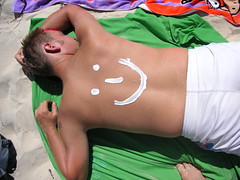
You have heard over and over how important it is to wear sunscreen, but how often do you actually wear it? The American Academy of Dermatology recommends wearing sunscreen with a Sun Protection Factor (SPF) of at least 15 every day, year-round to protect yourself from incidental sun exposure. If you choose not to wear sunscreen because you think it’s too greasy, it clogs your pores, it’s too expensive or it stings your eyes when you sweat, there’s good news: More and more options are becoming available to make sunscreen use easier and more convenient.
The Importance of Sunscreen
It cannot be stressed enough how important sunscreen is. The purpose of using sunscreen is to protect the skin from repeated or prolonged UVA and UVB radiation from the sun – lessening the risk of skin damage or skin cancer. Although the American Academy of Dermatology recommends wearing a sunscreen with SPF 15 or higher year-round, it is especially important to wear it when you will be exposed to sunlight for more than 20 minutes – no matter if the sun is shining or it’s cloudy.
Most people are understandably confused when it comes to choosing a sunscreen because of the baffling array of available choices. Common questions about sunscreens include
* How high should the SPF be?
* Should it block UVA or UVB?
* Does it matter whether it is a gel, cream, or spray?
* Should it be water-resistant or waterproof?
SPF stands for Sun Protection Factor. The higher the SPF number, the better protection against the sun's harmful UVB rays. The SPF number lets you know how much longer you can stay out of the sun without burning. For example, if it takes 15 minutes for a person to burn, an SPF 15 will allow them to stay out in the sun 15 times longer without burning.
The American Academy of Dermatology recommends wearing an SPF of 15 or higher for maximum protection. SPF is available in factors from 2-60. Does highest mean the best protection? Not necessarily. An SPF of 50 only provides 1-2% more protection than an SPF30.
UVA and UVB Protection
The label of the sunscreen will indicate the UVA or UVB protection.
UVA rays are responsible for the aging effect of the sun. However, overexposure to UVA rays can cause skin cancer.
UVB rays are responsible for sunburns and skin cancer.
Choose a product that has states "UVA/UVB" protection or has "broad spectrum" protectant.
Most experts recommend reading the list of ingredients in a sunscreen to see if it has broad-spectrum (UVA and UVB) coverage. Many products labeled as "broad spectrum" or "UVA blockers" do not adequately block UVA rays. A good broad-spectrum sunscreen should contain avobenzone, ecamsule (Mexoryl), titanium dioxide, or zinc oxide for significant UVA protection.
Whether you choose a lotion, stick, gel, or cream sunscreen depends largely on your skin type and personal preference. Oil-free gels are good solutions for facial skin prone to breakouts, and sprays may make application to the back and shoulders easier.
"Water-resistant" sunscreens should retain their protective ability for at least 40 minutes in water. Those labeled "waterproof" should protect the skin for 80 minutes in water.
The American Academy of Dermatology recommends using a broad-spectrum sunscreen with an SPF of at least 15 on a daily basis throughout the year. An important note is that no sunscreen can be effective unless it is properly and frequently applied.
You should apply at least one ounce of sunscreen 15 to 30 minutes before heading outdoors. Don’t be afraid to be liberal with your sunscreen – especially if you will be around sand, water or snow (because UV rays will be more intense). Don’t forget to cover all exposed skin – from the tips of your ears to the tips of your toes. Also be sure to reapply every two hours. If you are in the water or sweating heavily, you should reapply immediately after the activity.
Choosing a Sunscreen for Babies
It's better to keep your baby out of the sun altogether if you can. But when that's not possible, I recommend choosing a "physical" or "chemical-free" sunscreen made with zinc oxide or titanium dioxide — look for one of those ingredients on the label.
Unlike chemical sunscreens, which may cause irritation or allergic reactions because the skin absorbs the active ingredients, zinc oxide and titanium dioxide sit on top of the skin, forming a barrier against the sun's rays. There's no evidence chemical sunscreens are dangerous or toxic, but we just don't know enough yet about how young children react to the ingredients. Also, sunscreens with zinc oxide or titanium dioxide start protecting as soon as you put them on, whereas chemical products need to be slathered on 30 minutes in advance so the skin has time to absorb them.
If you do use a chemical-based sunscreen, do a patch test first to make sure your child won't have a reaction to it. Apply a small amount to the inside of her upper arm. If she develops a rash or redness at the site by the next day, choose another formula instead. Also make sure any chemical sunscreen you use is labeled "PABA-free." PABA was once widely used in sunscreens but now has been linked with skin irritation.

No comments:
Post a Comment